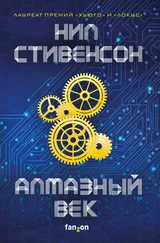“Got it,” Bob said. “So, if we hear a loud noise, we should wait for one of them to get after us with an air tank.”
“You shouldn’t have to wait long,” T.R. assured them, “and the argon won’t hurt you while you’re waiting. It’s—”
“An element,” Saskia said.
“Bingo. An inert gas. A noble gas, Your Majesty. There will be plenty of time to ride the elevator to the top, where we will serve drinks.”
“Sounds like my kind of emergency!” Bob said—a joke at his own expense.
“Any questions? Good. Having gotten the safety briefing out of the way, I propose to show you how the Biggest Gun in the World works from the bottom up, as this is the easiest way to understand it. And we are not quite at the bottom yet. This is Level Zero. I am told you both feel comfortable with ladders. Let’s put that to the test by descending to Level Minus One and beyond.”
A ladder was bolted to the stone wall, descending through a human-diameter hole in the grating. T.R. waited as one of the safety crew climbed down it, then followed with a certain amount of comical slapstick grunting and groaning intended to put them at ease. “Keep going!” he said to everyone. “’Til you cain’t go no more!”
Saskia and Bob took turns with the other crew members in descending to Level Minus One, then Minus Two, and so forth. At each level Saskia looked out at what was in the adjoining shaft, but after Minus One there was nothing to see except a blank wall of steel, curved to fit perfectly in the shaft. “The cylinder,” T.R. said at one point, noting her curiosity.
Minus Four sported a massive round hatch, a meter in diameter, let into the wall of that cylinder. Minus Five had nothing but routed systems of the smaller and more intricate type: sensors, probably networked to computers elsewhere. At Minus Six, the ladder stopped and they bottomed out on a natural limestone floor. “This is the base of the excavation,” T.R. said. “This is all the farther we dug. And this here”—he rapped a knuckle against the cylinder wall—“is the base of the cylinder, where the methane burns.”
Another round hatch was let into the steel wall here, and it was ajar, with an extension cord running into it from an outlet on the wall. T.R., with help from a crew member, shoved on the hatch, which was slow to get moving but then glided serenely. It opened inward. Saskia could see that it was designed to withstand internal pressure, like a bung on a barrel. The space beyond was illuminated well, if harshly, by an ordinary work light plugged into the extension cord. T.R. bent over and stepped through, beckoning Saskia to follow.
“The wall is so thick!” she exclaimed as she was stepping over the threshold. “To withstand pressure?”
“Ain’t really as thick as it looks,” T.R. demurred. “It’s got a cooling jacket all around it, coupla inches thick, but hollow—we pump water through it to keep it from overheating when it is bang, bang, banging away.”
“That would explain the cooling tower I noticed topside,” Bob said.
“Yep, and a lot of pipes and pumps along the way.”
They were now in a steel-walled chamber about five meters in diameter. Its floor was concave, a flattened dome, so they had to mind their footing. Below the level of the port, at about knee height, it was ringed with an array of stainless-steel orifices. Other than that the walls were featureless to a height of about four meters above their heads, where a sturdy steel ring had been welded into place, projecting just a few centimeters inward from the wall. Directly above that was a flattish dome that completely sealed off the portion of the cylinder above it. “That thing moves. You’re looking at the underside of the piston,” T.R. explained. “Down here, where we are, is where we explode shit.” He bent down and tapped one of the orifices. “These are coaxial. They let in compressed methane and compressed air at the same time. They let it in fast to keep reload time to a minimum. When we get the amount we want, we plug our ears and spark it off with these.” He pointed out a tiny detail Saskia hadn’t noticed before: little white ceramic knobs between the nozzles, with tiny metal parts projecting from the ends. “Plain old ordinary spark plugs from the car parts department at T.R. Mick’s. Volume discount.”
There wasn’t much else to say. They took turns stooping down and exiting the port. T.R., the last one out, carried the work light with him and pulled the extension cord out in his wake. The crew members pulled the hatch shut and latched it while others ascended the ladder to Minus Four, where earlier they’d seen another port-and-hatch. Entering into this one—which was just the upper portion of the same cylinder—they found themselves again on sloped footing, as they were now standing on the top of the domed piston whose underside they’d been gazing up at a few minutes ago.
Once they’d all found places to stand, T.R. said, “This here upper part will be filled with hydrogen gas, which is the working fluid that actually pushes the shell up the barrel. The physics of it is beyond me, but they say that the maximum velocity of the projectile can’t be any faster than the speed of sound in the gas that is doing the pushing. The speed of sound in light gases like hydrogen and helium is higher than that in air. Enough to make a difference for our purposes. We looked at helium. The world’s helium supply actually comes from up Amarillo way. It’s safer, but it’s expensive and hard to work with. If you build one of these at the doorstep of Germany, Your Majesty, you’ll want to take a hard look at helium. I can help you get some.”
“Very considerate of you as always, T.R.!”
“Anyways, we settled on hydrogen. Some of it’s gonna leak out and burn, but it’s a desert, so who cares? It’s easy to make more, on-site, from natural gas. So, at the same time the methane-air mix is filling the chamber below, we fill this volume with a certain amount of H 2. When the combustion chamber”—he pointed straight down—“goes boom, this piston we’re standing on gets forced upward, compressing the hydrogen. Which only has one way out.” He drew their attention to the top of the cylinder, ten meters above their heads, where it tapered inward like an upside-down funnel to an orifice in the middle about the size of a manhole. If the entire cylinder was a bottle, that was its mouth. “Let’s see where it goes!” he suggested, touching off another round of extension cord wrangling, hatch closing, and ladder climbing that took them up above the top of the massive steel cylinder to Minus One.
If the lower levels had been straight twentieth-century tech with their spark plugs and pistons, Minus One was all modern robotics. Slightly below them was a massive construct that could only be the “mouth” of the “bottle”—the upside-down funnel that accepted and channeled the pulse of hydrogen gas being driven upward by the rising piston. A short distance above that were the bottoms of the six barrels, which were simply cut off at their bases, open to the room. In between those obvious and easy-to-understand elements was an elaborate, massive, rotating contraption that, if Saskia was any judge of these things, had consumed the lion’s share of the engineering resources. She couldn’t really puzzle it out until T.R. issued a command that caused a vertical conveyor system to go into motion. This thing—“Shell hoist” on the cross-sectional diagram—had run parallel to the elevator all the way down from ground level. It served a similar purpose to the lift, but it was smaller and it ran much faster. After it had been whirring along for a minute or so, it slowed.
A giant bullet descended into the room. The bullet was a bit longer than Saskia was tall, and somewhat fatter than a beer keg. It was machined aluminum in some places, carbon fiber in others. It had a Flying S logo and was stenciled “RETURN TO FLYING S RANCH - REWARD” in English and Spanish. It glided down past them on the hoist and was seized by a massive robot arm, which pulled it away, indexed around, and fed it point-first into the base of one of the gun barrels. Another mechanism, pushing up from below, then rammed the shell upward until it had completely disappeared into the barrel. Something went kerchunk. The robot arm retracted, but the shell did not fall out.
Читать дальше
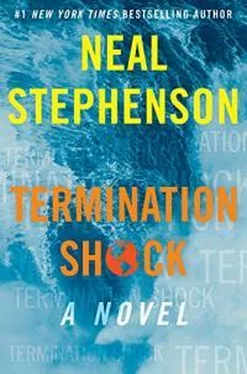
![Нил Стивенсон - Криптономикон [litres]](/books/23868/nil-stivenson-kriptonomikon-litres-thumb.webp)
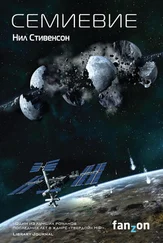
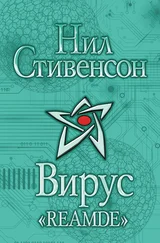



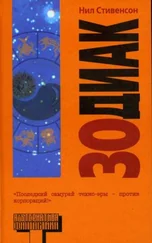

![Нил Стивенсон - Лавина [litres с оптимизированной обложкой]](/books/414066/nil-stivenson-lavina-litres-s-optimizirovannoj-ob-thumb.webp)
